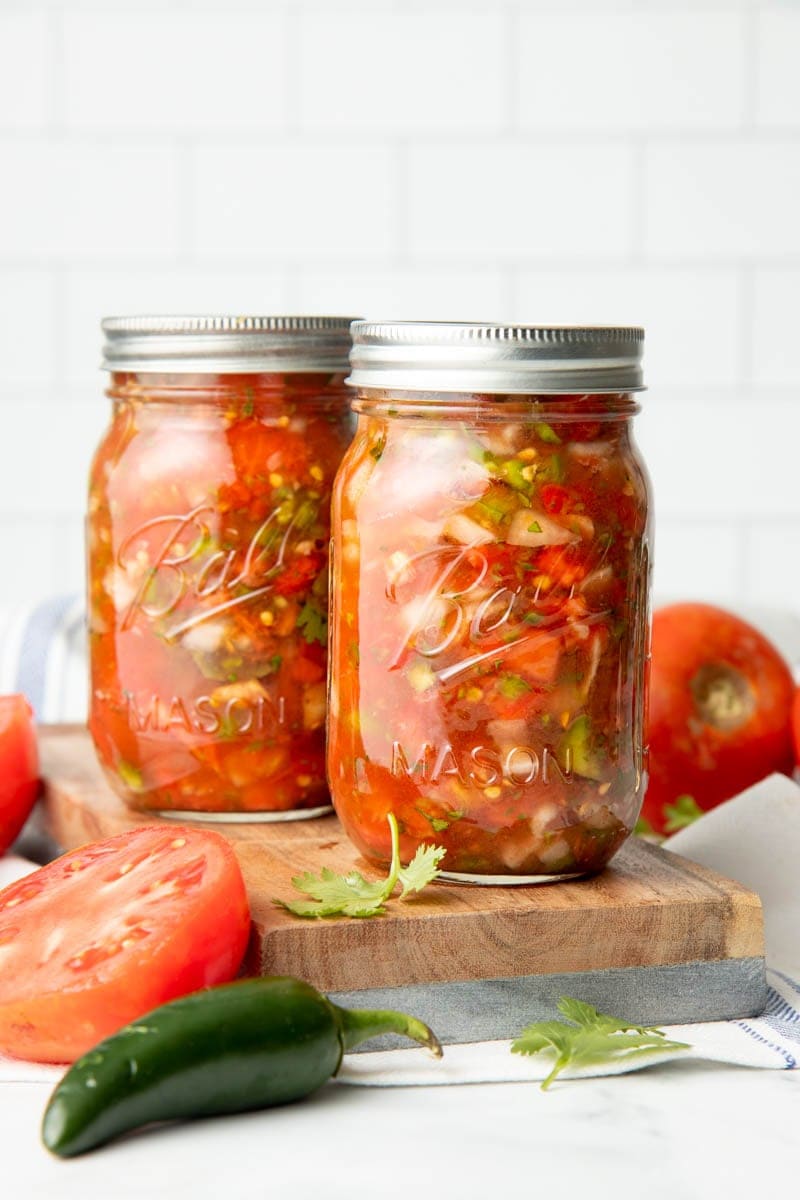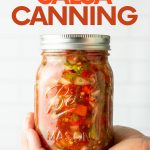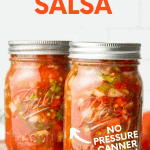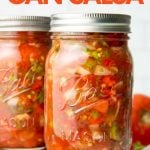We go through a lot of salsa in our house. We mix it into mashed avocado for quick guacamole, we spoon it into tacos, we use it in chili, and, of course, we make chips and salsa a regular snack, too!
With how much salsa we plow through in a year, it’s a good thing that canning salsa is stupendously easy to do. Before the end of summer, I like to have at least three dozen pints of my go-to salsa stashed away in our pantry. Canning salsa is a wonderful beginner canning project, and we’re going to show you everything you need to know to have your own stockpile of salsa.
The Ultimate Guide to Healthy School Lunches
We’ve packed (pun intended!) all our knowledge from years of making school lunches into one digital master guide!
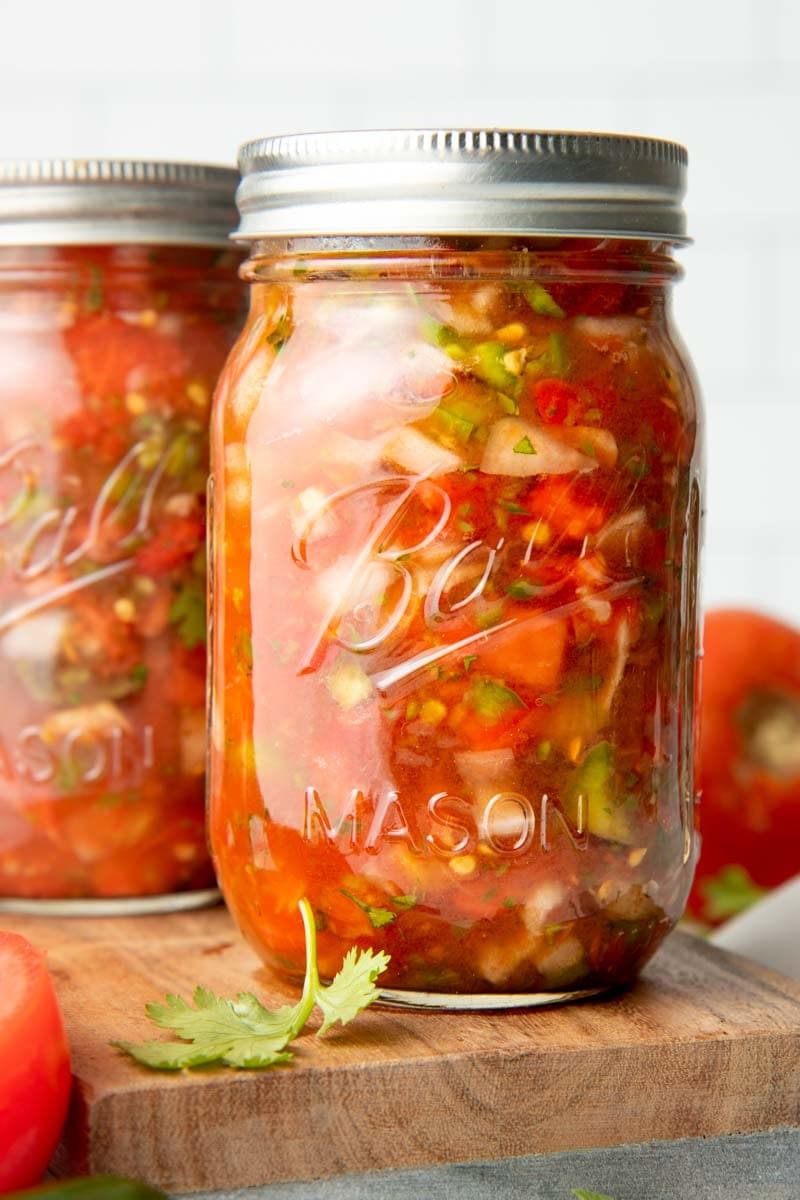
What’s the best salsa recipe for canning?
We’ve tried multiple different salsa recipes over the years, and we keep coming back to the standard Ball® Canning salsa recipe—Zesty Salsa. It’s easy to make, the flavor is spot on, and you can customize the spice level by changing the chile peppers you use. It’s the recipe we’ll use in this post!
Wholefully Protip
Tomatoes need to have the correct amount of acid added to be safe for water bath canning, so make sure to follow a tested recipe whenever canning salsa (or anytime!).
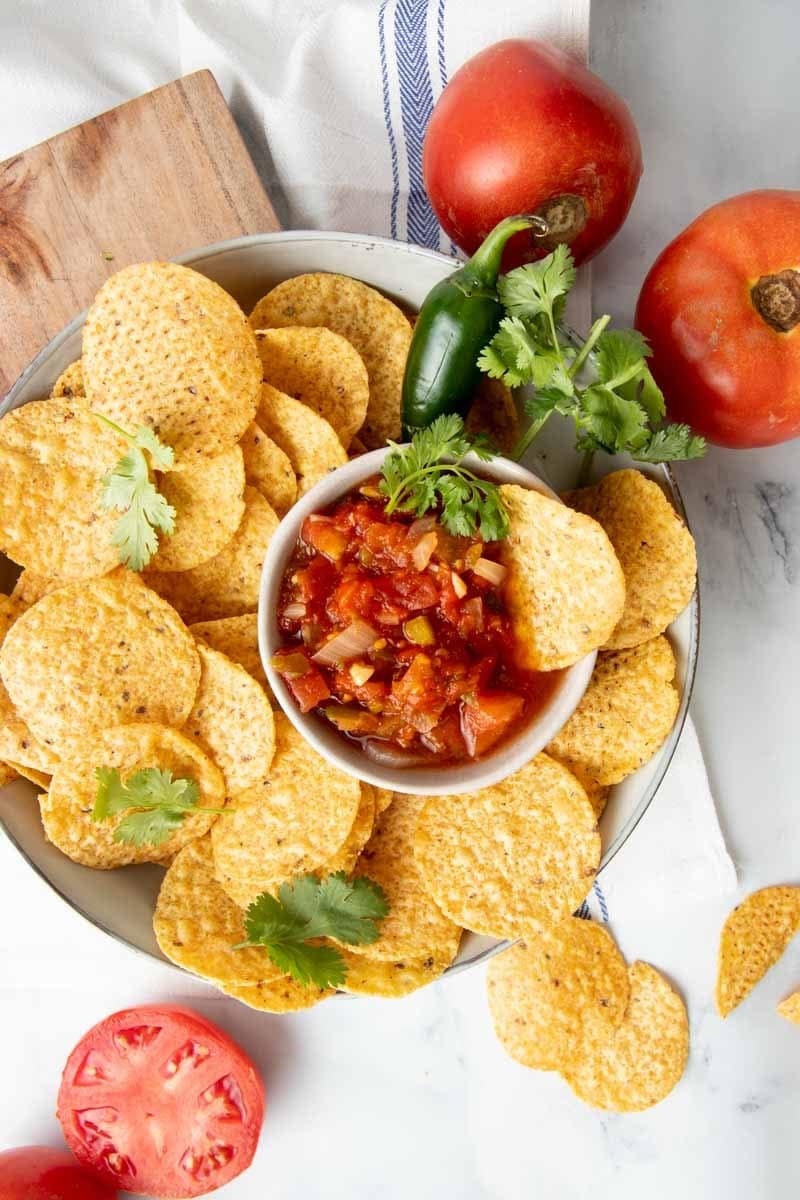
Tell me about canning salsa!
The process for canning salsa is similar to canning jam or canning pickles—just with a bit more chopping:
- Prepare your canner, jars, and lids, as we talk about in our intro to canning post.
- Blanch and peel your tomatoes. We cover how to do this extensively in our post on canning diced tomatoes.
- Dice the peeled tomatoes, peppers, onions, and garlic.
- Combine tomatoes, peppers, onions, garlic, vinegar, cilantro, and salt in a soup pot or Dutch oven.
- Bring to a boil, reduce heat, and cook, stirring frequently for about 10 minutes, or until thickened slightly.
- Ladle into prepared jars, remove air bubbles, wipe the rims of the jars, and then fit with lids and rings.
- Process in a boiling water bath canner for 15 minutes (adjusting time for altitude). Turn off the canner, remove the lid, and let the jars sit in the canner for 5 minutes.
- Transfer the jars to a spot to cool and seal. Check seals after 12-24 hours.
Protip: Try our video course!
More of a visual learner? Try our “Beginner’s Guide to Canning Salsa” video course!
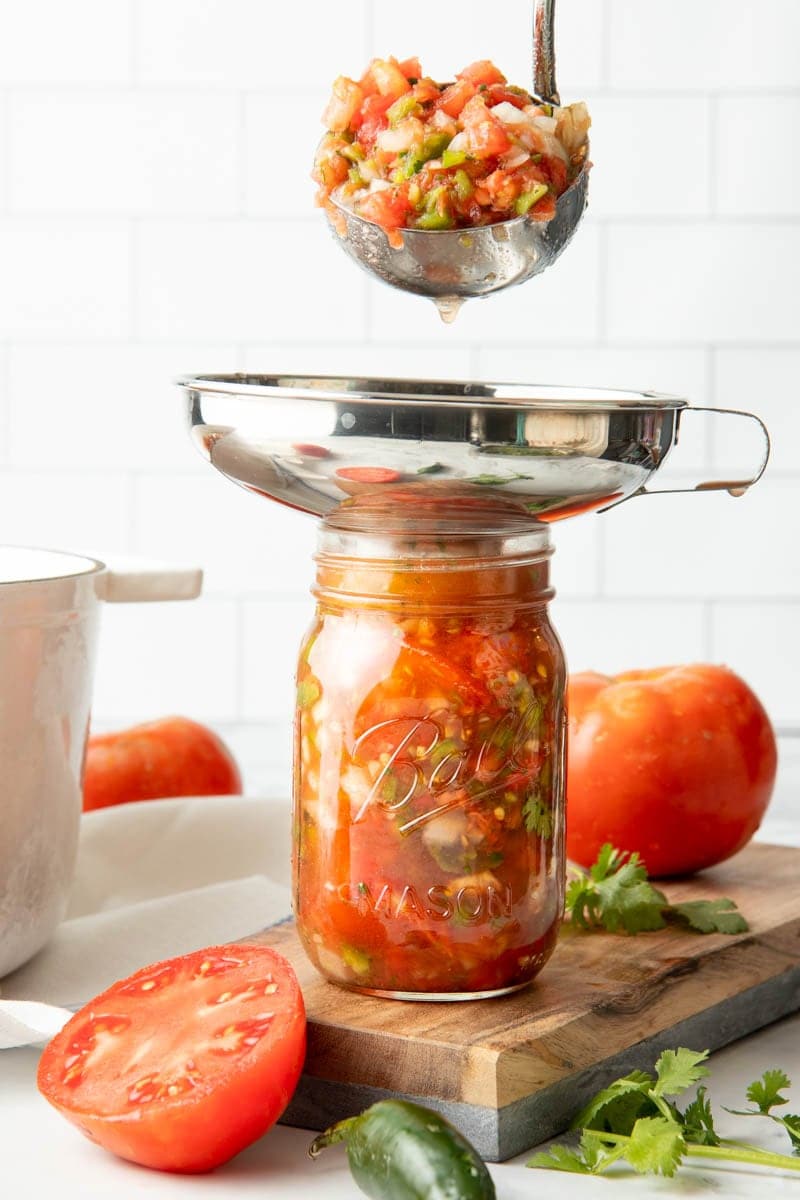
Do you have to cook salsa before canning?
We highly recommend it! Cooking tomato salsa before canning helps improve the quality of the final product in a few ways:
- It melds the flavors of tomatoes, peppers, onions, garlic, and other aromatics together to create a more refined flavor.
- It helps to reduce and thicken the salsa, making for a more intensified flavor and less liquidy texture.
- It helps break down the structure of the tomatoes so you get less separation between the juice and solids during canning.
Wholefully Protip
Cooking salsa before canning helps intensify the flavor and thicken the texture.
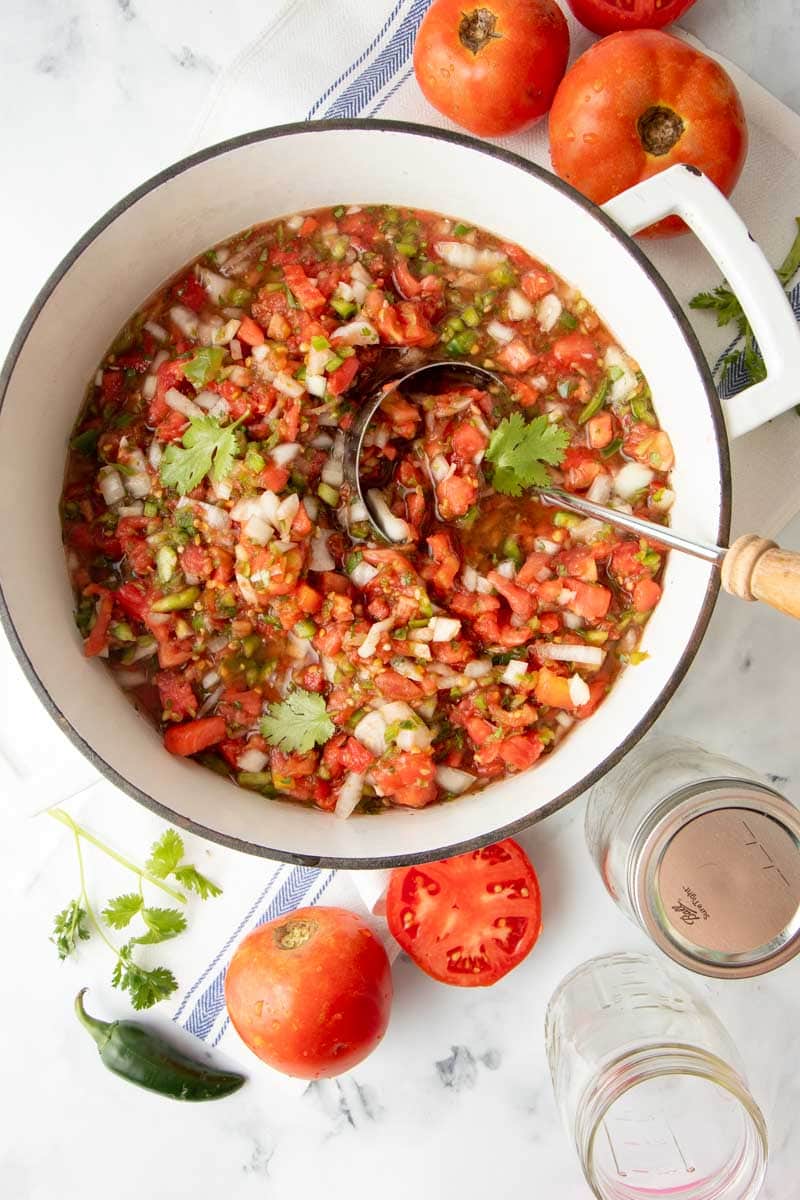
Does salsa need to be pressure canned?
Tomatoes are right on the border between high-acid foods (which can be safely water bath canned) and low-acid foods (which need to be pressure canned for safety). Because of this, it is vitally important to follow only tested salsa recipes when you want to water bath can—and follow them closely. The recipe we have listed out below is a tested recipe courtesy of Ball® Canning for water bath canning.
Wholefully Protip
By acidifying the tomatoes with vinegar, you can safely can this salsa recipe in a water bath canner.
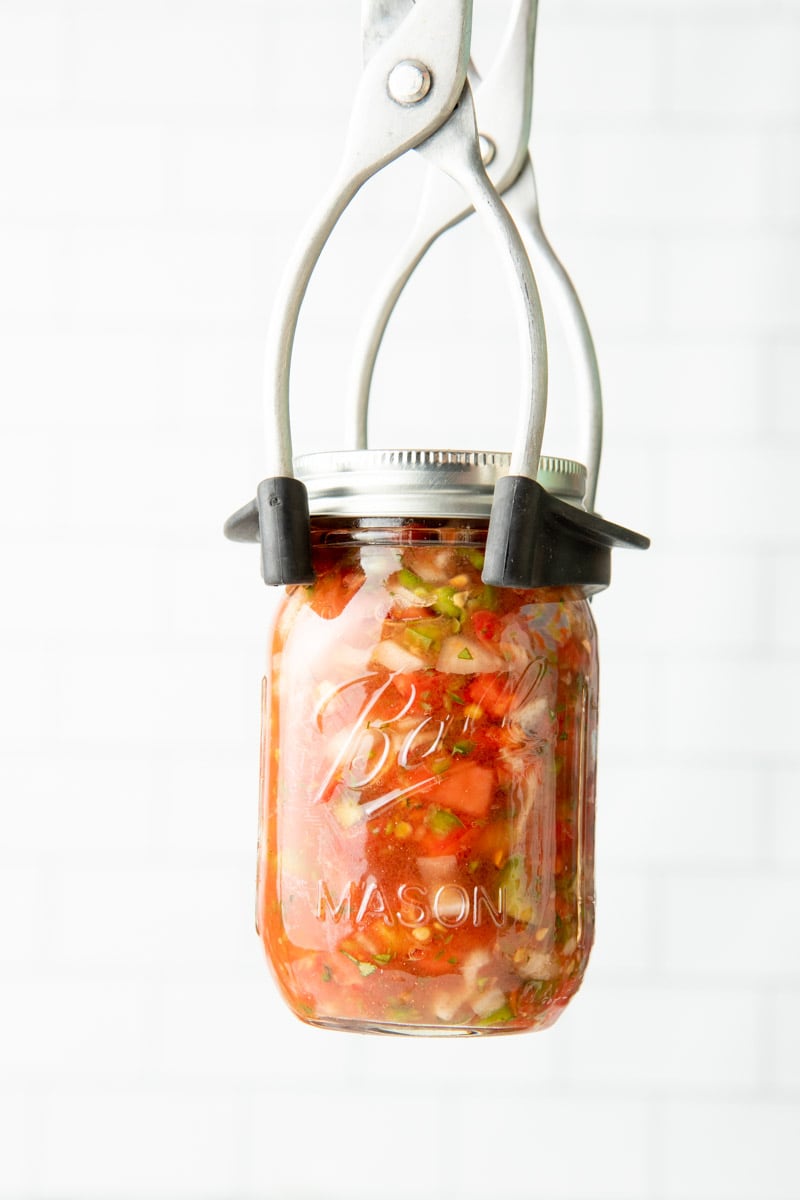
Do you have to put vinegar in canned salsa?
Vinegar works as an acidifier and it adds a wonderful tang to your salsa. Without vinegar, your salsa would not be acidic enough to safely water bath can.
Can I use lime juice instead of vinegar?
Because vinegar and lime juice do not have the same pH (acid) levels, they are not interchangeable in equal amounts in this recipe.
Wholefully Protip
To make hotter salsa, use spicier chile peppers like habanero; for a more mild salsa, stick with jalapeños.
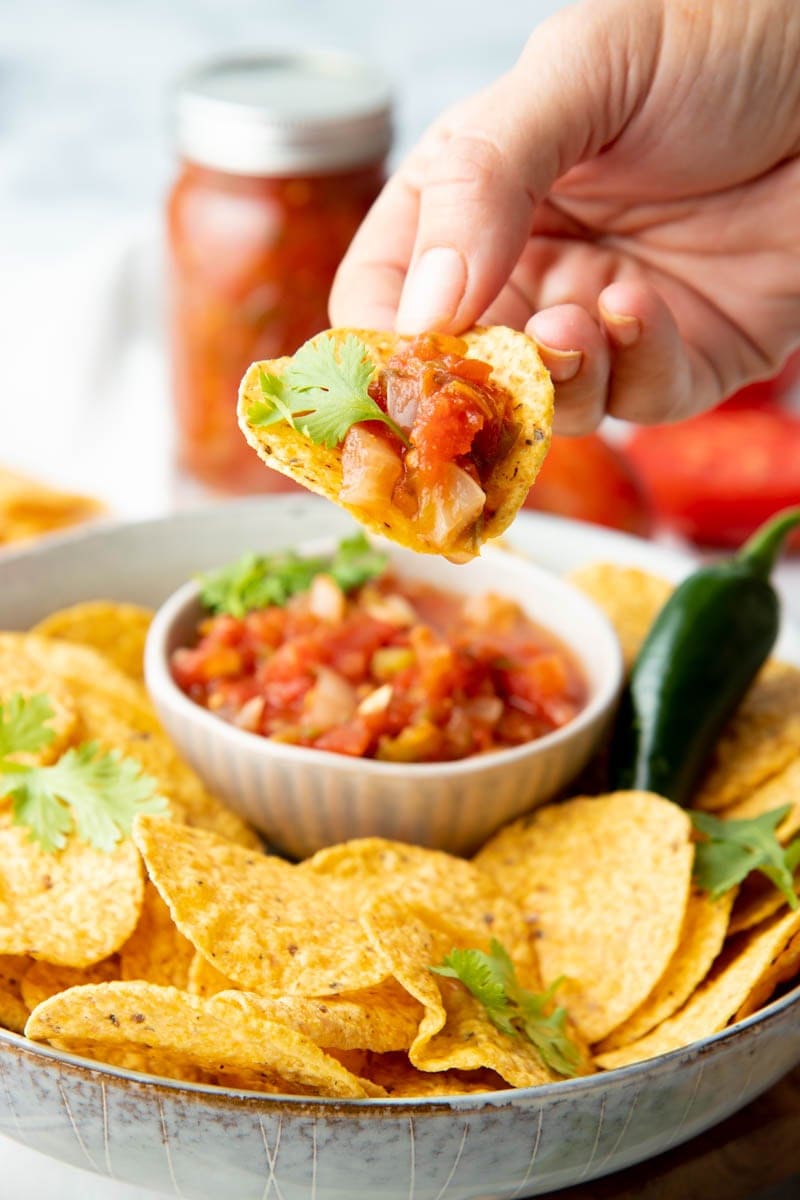
What are the best jars to can salsa in?
Salsa is pretty flexible on what jar it wants to live in! Here, we’re canning in Ball® Regular Mouth Pint Canning Jars. I find that the pint size is really good for salsa—it’s enough to have for a family snack or two without having so much that it gets lost in the back of the fridge. It’s also similar to the size of store-bought salsa jars, which make it easy to swap in for recipes.
I’ve also done salsa in the Ball® Collection Elite Pint in the past. Regular mouth, wide mouth, straight sided, jars with shoulders—they all work for salsa!
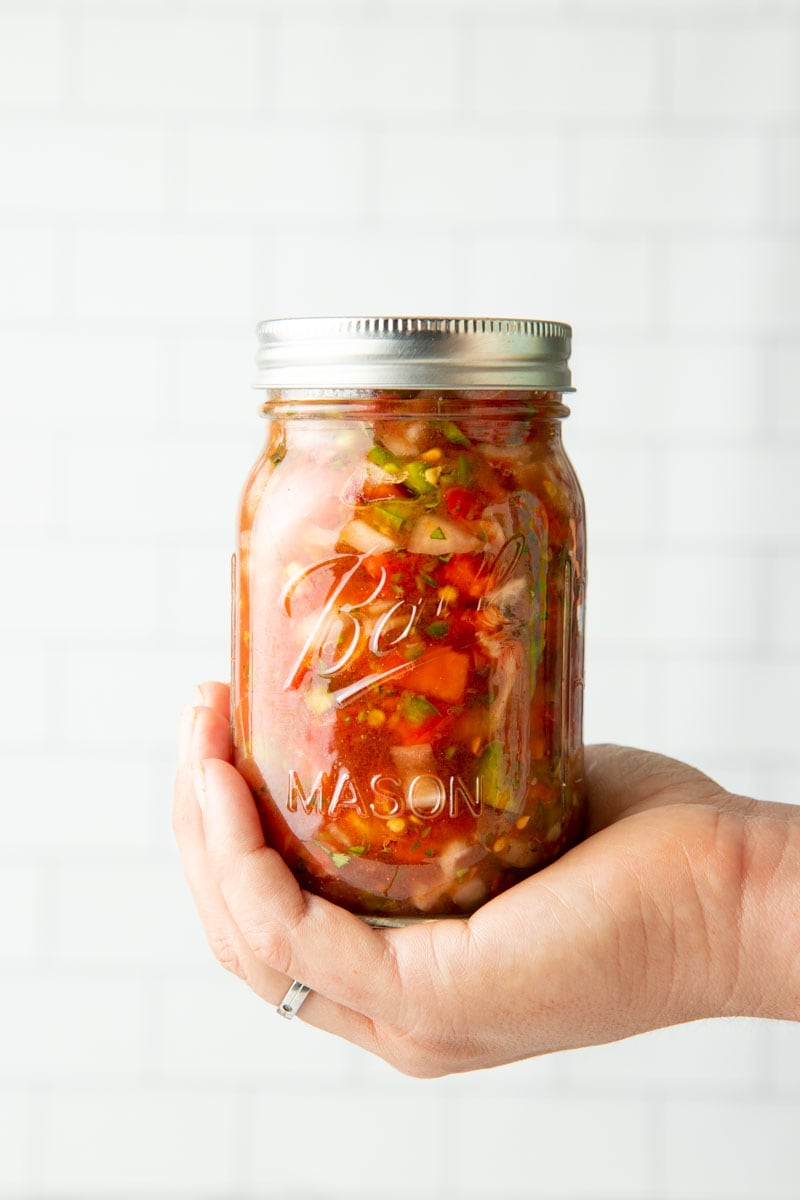
What are the best varieties of tomatoes to use for canning salsa?
A lot of people will answer this question saying that Roma or paste tomatoes are your best bet because of their low amount of seeds and thick flesh, but we have a different philosophy—the best tomatoes to use for canning salsa are the tomatoes you have!
I’ve mixed cherry tomatoes, Romas, heirlooms, beefsteaks—everything—into salsa with great results! Canning salsa is a great way to use up a hodgepodge of tomatoes.
Wholefully Protip
Most people prefer Roma or paste tomatoes for making salsa because of the low amount of seeds and thick flesh.
Do you have to peel tomatoes before canning salsa?
You don’t have to, but we recommend it. Depending on the tomato variety, sometimes the skins can become very tough during the canning process. We figure, better safe than sorry, and recommend peeling tomatoes first. Our method for peeling tomatoes outlined in our canning diced tomatoes post makes quick work of it!
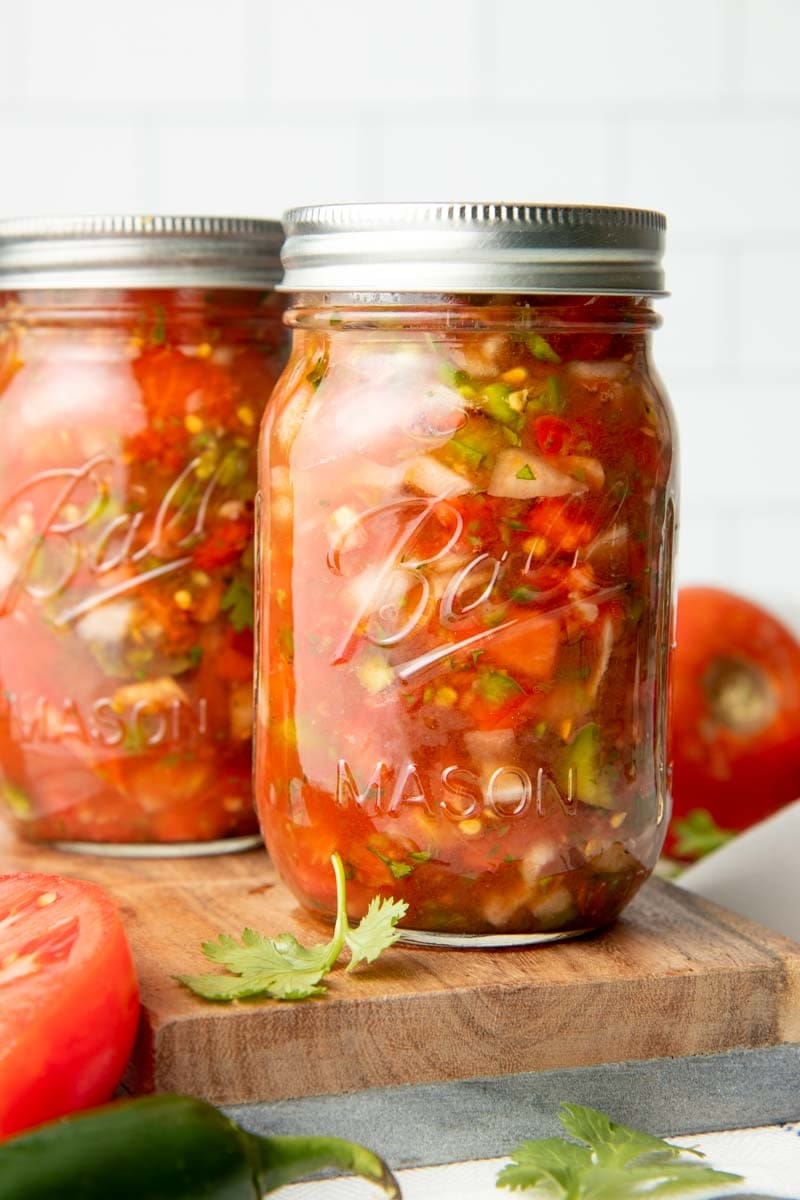
Can you freeze homemade salsa in jars instead of canning?
Sure can! Although you will see slight reduction in the quality of texture. Make sure to use freezer-safe Ball® Jars though, and only freeze up to the line identified on the jar. We recommend Ball® Wide Mouth Pint Jars for freezing.
How long can you keep canned homemade salsa?
Properly canned and sealed salsa has a shelf life of 18 months in a cool and dark spot. After that time, you might see a slight degradation of quality (taste, color, or texture), but as long as it is sealed well, it’s still perfectly safe to eat.
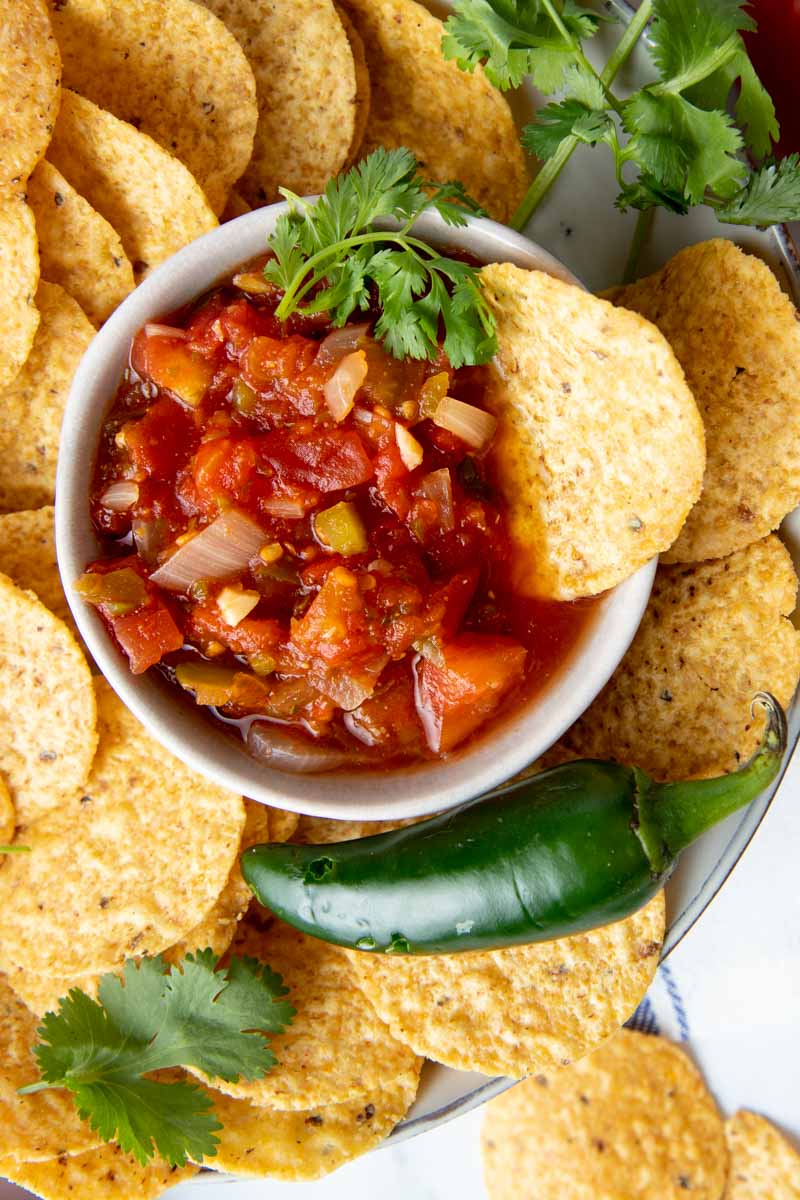
Feel free to multiply or divide the recipe below—but I’ll warn you, no matter how much salsa you put up, you’ll wish you had put up more! It’s amazing how quickly these jars seem to disappear in our house. Happy canning!
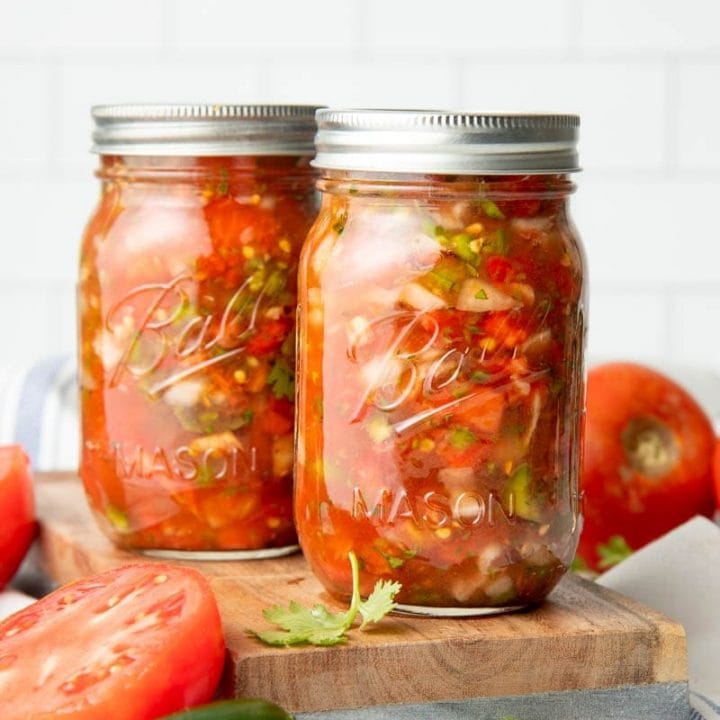
Homemade Salsa Recipe for Canning
Turn your windfall of tomatoes into salsa! We'll teach you everything about canning salsa, plus share our family favorite zesty salsa recipe for canning.
Ingredients
- 10 cups chopped cored peeled tomatoes (about 25 medium)
- 5 cups chopped seeded green bell peppers (about 4 large)
- 5 cups chopped onions (about 6 to 8 medium)
- 2 1/2 cups chopped seeded chili peppers, such as hot banana, Hungarian wax, serrano or jalapeño (about 13 medium)
- 1 1/4 cups cider vinegar
- 3 cloves garlic, finely chopped
- 2 tablespoons finely chopped cilantro
- 1 tablespoon salt
- 1 teaspoon hot pepper sauce, optional
Instructions
- Prepare boiling water canner. Heat jars in simmering water until ready for use. Do not boil. Wash lids in warm soapy water and set aside with bands
- Combine tomatoes, green peppers, onions, chili peppers, vinegar, garlic, cilantro, salt and hot pepper sauce, if using, in a large stainless steel saucepan. Bring to a boil over medium-high heat, stirring constantly. Reduce heat and boil gently, stirring frequently, until slightly thickened, about 10 minutes.
- Ladle hot salsa into hot jars, leaving 1/2 inch headspace. Remove air bubbles. Wipe jar rim. Center lid on jar and apply band, adjust to fingertip tight. Place jar in boiling water canner. Repeat until all jars are filled.
- Process both pint and half pint jars for 15 minutes, adjusting for altitude. Turn off heat, remove lid, let jars stand 5 minutes. Remove jars and cool 12-24 hours. Check lids for seal, they should not flex when center is pressed.
Nutrition Information:
Yield: 96 Serving Size: 2 tablespoonsAmount Per Serving: Calories: 14Total Fat: 0gSaturated Fat: 0gTrans Fat: 0gUnsaturated Fat: 0gCholesterol: 0mgSodium: 69mgCarbohydrates: 3gFiber: 1gSugar: 2gProtein: 0g
At Wholefully, we believe that good nutrition is about much more than just the numbers on the nutrition facts panel. Please use the above information as only a small part of what helps you decide what foods are nourishing for you.
Looking for more beginner canning recipes?
- Strawberry Jam. Put those sweet summer berries to good use with this classic strawberry jam.
- Tomato Sauce. When it comes to putting up tomatoes, we never skip tomato sauce. It’s just so versatile!
- Bread and Butter Pickles. Only four ingredients? Yup! This beginner pickle recipe is as simple as can be.
- Diced Tomatoes. Canning diced tomatoes is a regular part of late summer in our house. Learn how to make this pantry staple!

